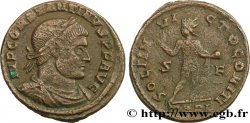E-auction 521-436016 - brm_587371 - CONSTANTINE I THE GREAT Follis ou nummus
You must signin and be an approved bidder to bid, LOGIN TO BID. Accounts are subject to approval and the approval process takes place within 48 hours. Do not wait until the day a sale closes to register. Clicking on « bid » constitutes acceptance of the terms of use of cgb.fr private e-auctions.
Bids must be placed in whole Euro amounts only. The sale will start closing at the time stated on the item description; any bids received at the site after the closing time will not be executed. Transmission times may vary and bids could be rejected if you wait until the last second. For further information ckeck the E-auctions F.A.Q.
NO BUYER'S FEE.
NO BUYER'S FEE.
| Estimate : | 95 € |
| Price : | 24 € |
| Maximum bid : | 24 € |
| End of the sale : | 10 April 2023 14:13:20 |
| bidders : | 8 bidders |
Type : Follis ou nummus
Date: 310
Mint name / Town : Siscia
Metal : copper
Diameter : 25 mm
Orientation dies : 6 h.
Weight : 6,25 g.
Rarity : R1
Officine: 1re
Coments on the condition:
Exemplaire sur un flan bien centré des deux côtés. Belle tête de Constantin Ier Auguste. Joli revers de style fin. Patine vert clair
Obverse
Obverse legend : IMP CONSTANTINVS P F AVG.
Obverse description : Tête laurée de Constantin Ier auguste à droite (O*).
Obverse translation : “Imperator Constantinus Pius Felix Augustus”, (L’empereur Constantin pieux heureux auguste).
Reverse
Reverse legend : GENIO AV-G-VSTI/ (CROISSANT)|A// SIS.
Reverse description : Genius (le Génie) debout à gauche, nu, coiffé du modius, le manteau sur l'épaule gauche, tenant une patère de la main droite et une corne d'abondance de la gauche.
Reverse translation : “Genio Augusti”, (Au Génie de l’auguste).
Commentary
Rubans de type 2 aux extrémités bouletées. Ce follis pour Constantin Auguste est bien frappé au 1/48 L. (poids théorique, 6,77 g). Première émission pour Constantin Ier Auguste qui avait du se contenter du titre de Filius Augustorum après la conférence de Carnuntum. Ce type semble en fait plus rare que ne le laissent supposer les ouvrages généraux.








 Report a mistake
Report a mistake Print the page
Print the page Share my selection
Share my selection Ask a question
Ask a question Consign / sell
Consign / sell
 Full data
Full data









